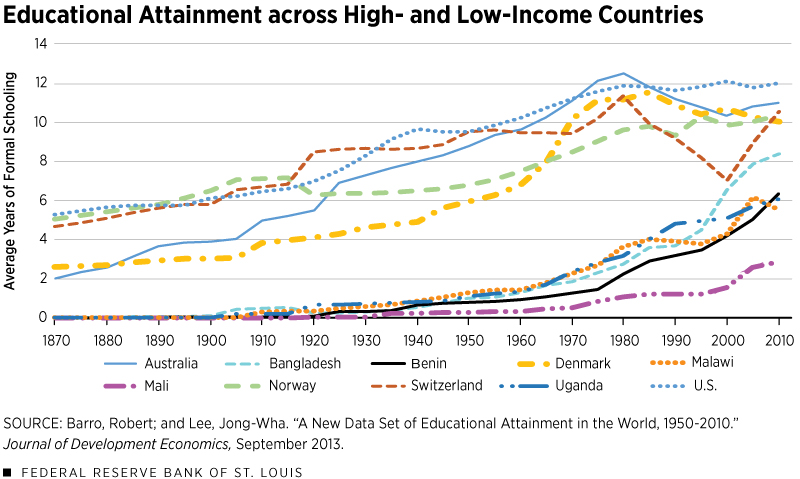For Poor Countries, Gains in Education Are Not Matched in Income

As the educational level of residents in poor countries improves, one would think that the income gap between poor and rich countries would narrow. But a Regional Economist article shows that poor countries are not catching up to rich nations in terms of GDP per capita despite the gains in education.
St. Louis Fed Research Officer and Economist Guillaume Vandenbroucke and former Research Associate Makenzie Peake compared real gross domestic product (GDP) per capita and educational attainment for a mix of high-income and low-income countries. They analyzed data from Australia, Denmark, Norway, Switzerland and the U.S. (the rich group) and Bangladesh, Benin, Malawi, Mali and Uganda (the poor group).
Gains in Education
From 1870 to 2010, they found that all the countries in their sample increased the average years of formal schooling for residents age 25 and older, as shown in the figure below.
“Rich countries have been enjoying higher levels of education for a long time, but the poor countries are catching up,” Vandenbroucke and Peake wrote. “In other words, schooling increases faster in poor countries than it does in rich countries.”

The authors noted that residents of the U.S., Switzerland and Norway had the highest levels of schooling in 1870 at around five years. Australia and Denmark followed, with slightly more than two years on average.
The low-income group averaged practically no schooling in 1870, they found. But levels of educational attainment began to advance significantly in the mid-20th century. By 2010, Bangladesh recorded more than eight years of education on average, approaching the 10 years seen in both Denmark and Norway. Malawi, Benin and Uganda attained about six years of schooling each by 2010.
The authors noted that some poorer countries showed minimal gains in education along with little growth in income. For example, Mali barely averaged three years of schooling per resident in 2010, making it the least educated country in the sample.
Gains in Income
Although GDP per capita increased among the all countries they studied, it didn’t grow as fast in poor countries as it did in rich countries.
“Poor countries are not catching up to the rich countries in terms of income,” Vandenbroucke and Peake wrote.

The contrast between the U.S. and Benin is illustrative, the authors pointed out. Between 1970 and 2010, GDP per capita in the U.S. more than doubled compared with only a 30% gain in Benin.
Since Benin’s GDP per capita in 1970 was $582 (versus $23,207 for the U.S.), they suggested that Benin actually lost ground relative to the U.S. “Put another way, Benin’s GDP per capita was 2.5% of U.S. GDP per capita in 1970,” they wrote. “In 2010, Benin’s GDP per capita had fallen to 1.6% of that of the U.S.”
Productivity and Education
Productivity growth is generally seen as a key determinant of GDP growth while also being determined by the education attainment of a country's population, the authors noted.
The figures above “indicate that the link from productivity to growth may be stronger than the link from education to productivity,” they wrote.
The incomes of poor countries, on average, are growing at lower rates than the incomes of rich countries. Consequently, they are becoming relatively poorer. For income convergence to occur, poor countries should grow at a higher rate than the rich countries, the authors wrote.
“Why are poor countries converging to the rich in terms of schooling but not income? If more schooling helps produce greater income, then why are poor countries not richer?” the authors posed.
Finding an answer to these questions may be pertinent to policymakers interested in helping poor countries, particularly for policies based on the assumption that building schools may be a way to help boost economic growth, they noted.
Their analysis indicates that “such policies can indeed enhance educational attainment but do not seem to effectively generate economic takeoff as well,” the authors concluded.
Additional Resources
- Regional Economist: Poor Countries Catching Rich Countries in Education, but Not Income
- Timely Topics: Why Are Some Countries So Rich and Others So Poor?
- On the Economy: Healthier Countries, if Not Wealthier Countries
Citation
ldquoFor Poor Countries, Gains in Education Are Not Matched in Income,rdquo St. Louis Fed On the Economy, Sept. 15, 2020.
This blog offers commentary, analysis and data from our economists and experts. Views expressed are not necessarily those of the St. Louis Fed or Federal Reserve System.
Email Us
All other blog-related questions

